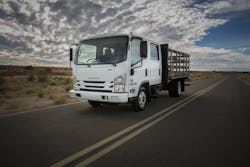Do you know your truck fleet’s total cost of ownership (TCO)? You should, because TCO is far more important than initial price when acquiring a vehicle.
“Understanding the TCO of any fleet is critical to success,” says John Schwegman, director, commercial products, fleet and commercial, General Motors (www.gm.com), which, along with its partners, produces vehicles in 30 countries. “While competitive procurement can assist in reducing fleet costs, a wide variety of direct and indirect cost and expenses are involved in the operation of fleets.”
“A total cost of ownership purchasing decision is one that is made by beginning with the end in mind,” says Adrian Ratza, marketing manager, Hino Trucks (www.hino.com), a Toyota Group Company that assembles, sells and services a lineup of Class 4 to 7 commercial trucks in the U.S. “The purchase price is a glaring factor that can be difficult to look past for some, but numerous factors past the initial purchase price will add up to play a major factor on the real cost of the vehicle by the time it is retired, plus will help maximize its ROI.”
“TCO is an analysis of the lifecycle cost of the truck from the cost of initial acquisition throughout the vehicle’s entire operating period,” explains Brian Tabel, executive director of marketing, Isuzu Commercial Truck of America (www.isuzucv.com), the distributor of Isuzu commercial vehicles in the U.S. All costs – initial purchase, routine operation, maintenance costs, replacement parts, repair expenses, vehicle depreciation and residual value at time of sale or trade – all factor into the total cost of ownership.
“Other TCO considerations include how long a fleet plans to keep the truck, miles per year, fuel costs, truck fuel economy, cost to hire and train drivers, vehicle downtime and costs of out-of-service days,” says Kurt Swihart, marketing director, Kenworth Truck Company (www.kenworth.com), a manufacturer of heavy and medium duty trucks, says.
Additional components of TCO, adds Carl Webb, vice president and general manager, medium duty truck line, Navistar International (www.navistar.com) – a manufacturer of commercial trucks, buses, defense vehicles and engines – includes:
- The cost of the truck and taxes/registration/other fees.
- Uptime – The amount of productive working time minus the unscheduled repair, which includes the costs of unplanned downtime.
- Financing charges.
- Insurance.
- Driver salary and benefits.
- Tolls.
- Permit fees.
- Costs of related equipment not acquired with the truck – e.g. truck bodies, trailers, APUs, chains, load locks, etc.
- Body integration uptime – How well the truck equipment works with the truck chassis to reduce operating costs.
Some of these cost elements “are one time or fixed costs and others are variable and occur/reoccur over the span of ownership,” says Webb. “The productive work of a truck is uptime, and the higher the percentage of uptime during the life of the truck, the better the TCO is.”
PAIN POINTS AND SAVINGS OPPORTUNITIES
“TCO means knowing all operating costs for each asset throughout its lifecycle,” says Frank Bussone, CTP, director of fleet planning services, AmeriQuest Transportation Services (www.ameriquestcorp.com/transportation), a provider of comprehensive fleet management services. “This is essential because when all costs are known, an operator can identify pain points and savings opportunities and use these costs to analyze the correct lifecycle for each asset in the fleet.”
Other than the driver’s salary, the three largest cost categories for trucks are: the fixed expense – lease or depreciation, maintenance and repair expenses and fuel expense, he points out. “With a Class 8 over-the-road tractor, fuel is the biggest category. However, in medium duty applications, fixed expense or maintenance and repair expenses are typically higher than fuel expense.”
It should be noted that TCO “is directly proportional to the total number of vehicles in its operation, which drives all direct fixed and operating costs, such as fuel, tire replacement expenses, depreciation, accident repair costs, insurance, maintenance and many other elements,” says GM’s Schwegman.
“Similarly, there are indirect fleet costs which are often harder to quantify, but have an impact on a fleet’s TCO,” he continues. “These include time spent on fleet management processes and administration and employee productivity factors such as driver downtime and motivation.”
Notes Isuzu’s Tabel: “TCO analysis can identify the costs of ownership that otherwise would not be in plain sight. TCO presents the opportunity to plan and ultimately control costs. Lifecycle cost is the result of TCO analysis and planning.”
CONCENTRATION AREAS
When figuring TCO, it is wise to pay attention to a number of fundamental considerations. Chief among them: powertrain and specs; vehicle design features; reduced-maintenance components and systems; reliability and durability; warranty; and after sales support.
- Powertrain and Specs
It’s necessary to pair vehicle requirements with a powertrain that will meet the gross vehicle weight rating and provide enough horsepower and torque best suited to the application, says Tabel of Isuzu.
AmeriQuest’s Bussone says numerous types of truck specifications directly correlate to fuel economy. These include the appropriate ECM settings, gear ratio, automatic transmissions and engine type.
In addition to diesel and gasoline engines, TCO calculations could include alternative fuels and propulsion types like hybrids and electric, as well as innovations that assist in fuel economy, GM’s Schwegman adds. These include such technologies as active fuel management systems, oil life monitoring, start-stop systems and creep mode.
- Vehicle Design Features
Year after year, OEMs are tweaking vehicle design features and options to reduce drag and maximize fuel economy as part of their effort to meet the increasingly more stringent fuel economy and emissions regulations, observes Bussone of AmeriQuest.
Vehicle body type and application is a major component that influences the design features of a truck, Isuzu’s Tabel says. Typically, an accessory air dam installed on the roof of the truck cab can reduce drag and help maximize fuel economy.
- Components and Systems that Require Little or No Maintenance
Fleet maintenance costs can be lowered by spec’ing components and systems that require little or no maintenance, using synthetic oils and lubricants, extending service intervals, establishing and adhering to effective preventive maintenance practices, etc.
“Components and systems are a maintenance cost that will factor into TCO,” Hino’s Ratza, points out. “The more maintenance a component and a system require, the more cost will be associated with the vehicle and the increase in TCO.”
Drilling down into the data and analyzing the Vehicle Maintenance Reporting Standards (VMRS) codes associated with vehicle components and systems will help identify problem areas when they do arise, says AmeriQuest’s Bussone.
VMRS is the universal language of the trucking industry for tracking and communicating equipment and maintenance information. It was developed by the Technology & Maintenance Council (TMC), North America’s premier technical society for truck equipment technology and maintenance professionals (www.trucking.org/Technology_Council.aspx).
“Tried and true designs, parts and what a truck owner has had good luck with in the past” can play an important factor in making good specification decisions for future medium duty truck purchases, says Kenworth’s Swihart.
“We are seeing rapid improvements in fuel economy through powertrain integration,” he says. “The electronics added to trucks today helps lower TCO through the use of more appropriate driver routes and increased driver efficiency, and can also help enhance safety.”
“Component selection can influence the TCO based on the durable life, reliability or impact on variable costs, such as scheduled service or fuel efficiency,” adds Navistar’s Webb.
- Reliability and Durability
Reliability and durability equals greater uptime and less costs says Ratza of Hino. Not just the costs associated with getting the vehicle up and running, but the costs related to vehicle downtime and the inconvenience to fleets and their customers.
A total cost of ownership calculation also can be used to compare the costs associated with owning and operating vehicles of various OEMs, points out GM’s Schwegman.
A fleet can conduct TCO analyses to compare the total amount spent – also called total spend – for several different brands/models of trucks when they reached 50,000 miles, for example, says Bussone of AmeriQuest. “Which OEM’s vehicle or OEM component was more reliable compared to another? How did this reliability affect the overall total operating cost?”
- Warranty
The officials concurred that warranty – including duration, coverage and options – should be considered in a TCO study. A longer and more comprehensive warranty lowers TCO by helping mitigate out-of-pocket costs for failures outside of normal wear and tear.
“A purchase of a vehicle with a weaker warranty can mean lesser cost up front, but it could also have devastating consequences on TCO if the truck requires major repairs that a stronger warranty would have covered,” notes Hino’s Ratza.
AmeriQuest’s Bussone advises fleets to “drill down into their data to compare what their maintenance and repair expenses have historically been on a certain component, such as an air conditioner, to the price of the warranty for that component. The results of this exercise will determine which warranty items to purchase.”
- After Sales Support
After sales support should not be overlooked when figuring TCO.
Look for truck dealers and manufacturers that partner to offer the best total customer support experience to maximize TCO, advises Ratza of Hino. If a truck goes down, this should encompass:
- Clear and quick communication on what the truck’s issue is so the best course of action can be determined.
- The dealer and OEM working together to diagnose the problem as quickly as possible and ensure needed parts are on hand to fix the vehicle.
- Doing whatever else it takes to minimize the truck’s downtime.
What’s more, fleets should look for programs that help maximize vehicle ownership, recommends Tabel of Isuzu. These can include covered maintenance programs, priority service maintenance programs, vehicle “health” reports and parts programs.
Along with looking for dealers that have experience in spec’ing and selling the types of trucks required, fleets should be sure the dealer’s service departments have the facilities, tools, equipment and certified technicians to accommodate the fleet’s specific needs, GM’s Schwegman adds.
SEEK DATA
AmeriQuest’s Bussone advises taking a hands-on approach and tapping into the raw data usually found behind the scenes of operational dashboards and reports. “Collect data from such sources as onboard truck computers, maintenance software from the shop and accounting/financial systems and use software and models to analyze the information and calculate the lifecycle sweet spot.”
Well-integrated telematics software provides fleets a comprehensive solution into gaining insight into a various number of fleet-efficiency benchmarks by gathering data on common metrics, adds Hino’s Ratza. These include fuel and DEF economy, and monitoring driver behavior like hard acceleration and hard braking.
“The role telematics will play in TCO is a major one now, and that role will only expand in the future,” he says.
“Be sure not to overlook the costs associated with in-servicing a new truck and preparing it for the road,” Bussone adds. “Conversely, do not overlook the costs associated with getting it ready for a trade or sale.”
Ratza warns that any TCO calculation done off of a past purchase may not apply to a future purchase “unless the prospective future purchase will have a similar duty cycle. Where and how a truck is driven will also play major roles in its TCO.”
Both Isuzu’s Tabel and Kenworth’s Swihart note that OEM dealer sales representatives are trained on effectively calculating TCO costs and on assisting truck buyers evaluate and assess planned operation of their trucks. Various TCO calculators can be applied to a fleet’s requirements and specs.
“It is very difficult to apply a hard and fast rule to TCO, but fleets that understand how to apply this to their fleet will have taken massive steps in maximizing their fleet ROI,” says Ratza.
“Don’t buy on initial price alone until you’ve seen the entire picture,” Swihart concludes, “then make the best decision available to you.”
About the Author

